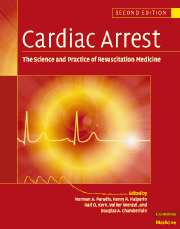Book contents
- Frontmatter
- Contents
- List of contributors
- Foreword
- Preface
- Part I Introduction
- Part II Basic science
- Part III The pathophysiology of global ischemia and reperfusion
- Part IV Therapy of sudden death
- Part V Postresuscitation disease and its care
- Part VI Special resuscitation circumstances
- Part VII Special issues in resuscitation
- 66 The ethics of resuscitation and end of life decisions
- 67 The economics of treating sudden cardiac arrest
- 68 Medicolegal aspects
- 69 The near-death experience, long-term psychological outcomes and support of survivors
- 70 CPR training
- 71 Consensus development in resuscitation: the growing movement towards international emergency cardiovascular care guidelines
- Index
68 - Medicolegal aspects
from Part VII - Special issues in resuscitation
Published online by Cambridge University Press: 06 January 2010
- Frontmatter
- Contents
- List of contributors
- Foreword
- Preface
- Part I Introduction
- Part II Basic science
- Part III The pathophysiology of global ischemia and reperfusion
- Part IV Therapy of sudden death
- Part V Postresuscitation disease and its care
- Part VI Special resuscitation circumstances
- Part VII Special issues in resuscitation
- 66 The ethics of resuscitation and end of life decisions
- 67 The economics of treating sudden cardiac arrest
- 68 Medicolegal aspects
- 69 The near-death experience, long-term psychological outcomes and support of survivors
- 70 CPR training
- 71 Consensus development in resuscitation: the growing movement towards international emergency cardiovascular care guidelines
- Index
Summary
Part 1: Introduction
Discussing the law in the context of cardiovascular resuscitation would seem to involve a small number of topics. Most commonly, one might consider the malpractice consequences of negligence in the conduct of medical personnel performing cardiopulmonary resuscitation for a dying patient. Certainly, malpractice law is a legal aspect of cardiopulmonary resuscitation (CPR). Yet, because of the nature of the act of CPR, it rarely, alone, becomes the focus of malpractice litigation. Most commonly, malpractice litigation focuses upon the alleged malpractice that leads up to a patient 's resuscitation. However, when the resuscitative efforts of medical professionals are the focus of a malpractice suit, the legal theories may be similar to those one may find in other malpractice litigation (e.g., negligent administration of drugs or negligently performing procedures) to more unique causes of action that arise from the resuscitation of a patient with Do-Not-Resuscitate (DNR) orders, such as the wrongful life legal complaint when the patient designated as a “DNR patient” is successfully resuscitated. Indeed, the more one delves into topics related to the law and CPR, the more one finds that to do adequate justice to the topic one must study the bioethics of death and dying and the evolution of advanced directives and how they apply to all patients – competent and incompetent alike. Because the law relating to death and dying is at the cusp of the interface between bioethics and the law, one must also pursue an understanding of the evolution of our laws as they relate to personhood, self-autonomy, and privacy.
- Type
- Chapter
- Information
- Cardiac ArrestThe Science and Practice of Resuscitation Medicine, pp. 1226 - 1243Publisher: Cambridge University PressPrint publication year: 2007
- 1
- Cited by



